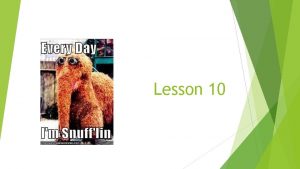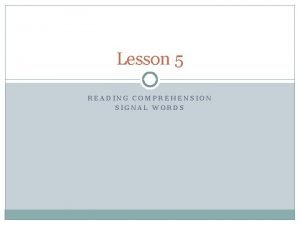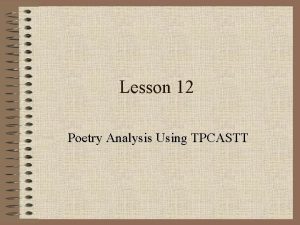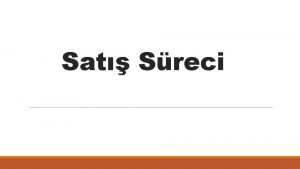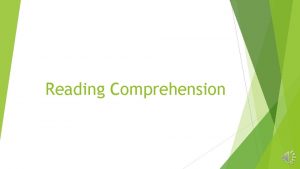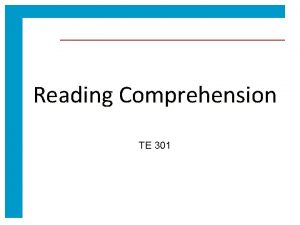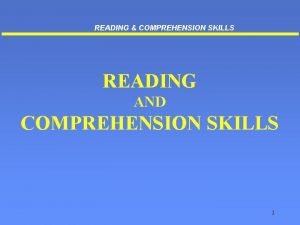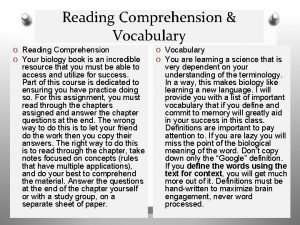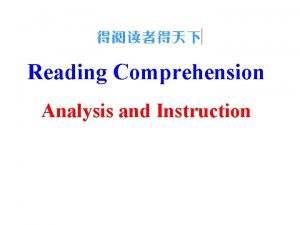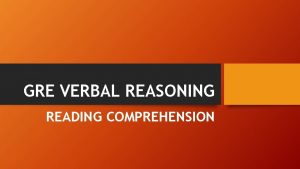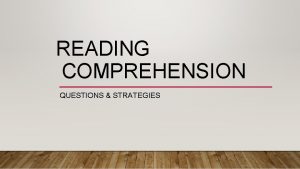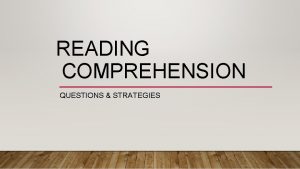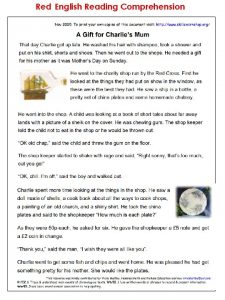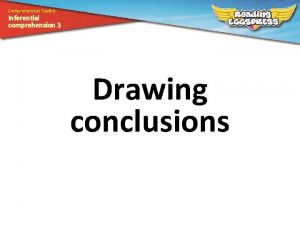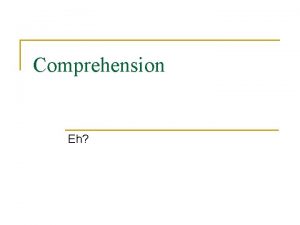Lesson 10 Todays Agenda SAT Reading Comprehension Note
















- Slides: 16

Lesson 10

Today’s Agenda SAT: Reading Comprehension Note Finish and Practice Activity 4. 6 – Drafting My Credo OBJECTIVES: ~become familiar with the Critical Reading Section of the SAT ` analyze the elements of a credo as a literary genre ~apply the conventions of the credo genre when writing a personal credo, using effective syntax and punctuation

SAT: Critical Reading

Quick Overview 24 -Question Critical Reading Section (25 minutes) 1 -8 Sentence Completion 9 -12 Reading Comprehension (2 short passages) 13 -24 Reading Comprehension (1 long passages) 24 -Question Critical Reading Section (25 minutes) 1 -5 Sentence Completion 6 -9 Reading Comprehension (paired short passages) 10 -24 Reading Comprehension (2 long passages) 19 -Question Critical Reading Section (20 minutes) 1 -6 Sentence Completion 7 -19 Reading Comprehension (paired long passages)

General Testing Tips Read the Introductions Almost every reading passage is preceded by an italicized introduction. DON’T SKIP IT. The following passages are excerpted from books on America’s national pastime, baseball. Passage 1 is taken from an account of a particularly memorable season. Passage 2 is from a meditation on the game written in 1989 by the late literary scholar A. Barttlett Giamatti, then commissioner of baseball. Tackle passages with familiar subjects first. Try to answer all the questions on a particular passage. You don’t have to answer questions in the order they are presented. Scan the passage topics and start with the topic that seems easiest for you. Questions are not arranged in order of difficulty. Skip the ones that stump you and continue to answer questions. Sometimes, answering a few other questions over the same passage will help you on the one that originally stumped you. When asked to choose a title, watch out for choices that are too specific or too broad. Title should include central theme that is developed.

General Testing Tips Spot the major reading question types. Main Idea Check opening and closing sentences of each paragraph. Whom or what is this passage about? What aspect of this subject is the author talking about? What is the author trying to get across? Specific Details Inferences Answer will NOT be explicitly stated in the text. Tone/Attitude Vocabulary Context Technique in Relationships between Development of the paragraphs passage

Practice Lois Mailou Jones is one example of an answer to the charge that there are no Black or female American artists to include in art history textbooks and classes. Beginning her formal art education at the School of the Museum of Fine Arts in Boston, Lois Jones found herself strongly attracted to design rather than fine arts. After teaching for a awhile, she went to Paris to study, on the advice of the sculptor Meta Warrick Fuller. It was in Paris that she first felt free to paint. Following her return to this country in 1938, Jones had an exhibit at the Vose Gallery in Boston, a major breakthrough for a Black artist at that time. Her work during this period consisted of excellent impressionist scene of Paris. It was not until the early 1940 s, after she met the Black aesthetician Alain Locke, that she began to paint works like Mob Victim, which explicitly dealt with her own background as a Black American. Later, in the 50 s, she went often to Haiti, which had yet another influence on her style. Then a sabbatical leave in Africa again changed her imagery. Indeed, the scope of this distinguished artist’s career so well spans the development of twentieth-century art that her work could be a textbook in itself.

Main Idea Practice 1. Read first and last sentences of the two paragraphs. 2. What are those sentences about? The passage primarily focuses on the a. influence of Lois Jones on other artists b. recognition given to Lois Jones for her work c. experiences that influenced the work of Lois Jones d. obstacles that Lois Jones surmounted in her career e. techniques that characterize the work of Lois Jones

Choosing a Title Practice Which of the following is the best title for the passage? a. Unsung Black Artists of America b. A Hard Row to Hoe: The Struggles of Lois Jones c. Locke and Jones; Two Black Artistic Pioneers d. African and Haitian Influences on Lois Mailou Jones e. The Making of an Artist: Lois Mailou Jones

Specific Details Practice In what way did her meeting with Alain Locke affect Jones’s work as an artist? a. It inspired her to focus on French impressionist landscapes. b. It influenced her to paint scenes from Black American life. c. It encouraged her use of Caribbean and African imagery. d. It led to a prestigious gallery showing of her paintings. e. It confirmed the feasibility of her pursuing a career as an artist.

Activity 4. 6 Drafting My Credo

Precepts A precept is a rule, instruction, or principle that guides somebody’s actions and/or moral behavior. In the graphic organizer, list some of the precepts you have learned over the course of your life that guide your behavior, as well as why they are significant to you. Precepts 1. Don’t cut in front of people— always wait your turn. Rationale, Significance, or Reflection 1. Timing is everything. If we are not patient and we cut people off because we are in a hurry, we might miss out on a great opportunity that was waiting for us. We will have missed it and the person behind us might benefit from it.

Predict the TONE of the selection.

Credo from All I Really Need to Know I Learned in Kindergarten (272) As you read the credo, consider what the precepts have in common and highlight those that most appeal to you personally. Robert Fulghum (b. 1937) grew up in Texas. He was a minister for many years before turning to writing, painting, and sculpting. He is the author of several best-selling books that primarily focus on thoughts about how to live a full and happy life. Fulghum has said, “The tragedy of modern man is not that he knows less and less about the meaning of his own life but that it bothers him less and less. ”

After Reading - page 273 What are your reactions to Fulghum’s credo? What precepts seem to make the most/least sense to you personally, and why? TERMS TO KNOW GENRE CONVENTIONS If a personal credo can be considered a literary genre, what are some conventions that would characterize this genre? EXPLANATION OF INSPIRATION PRECEPTS CALL TO ACTION What is his TONE? MATTER-OF-FACT How did he create the tone? Simple Diction Dashes Ellipsis Imperative Sentences

Writing Prompt - HOMEWORK Emulating Fulghum’s structure and conventions, draft a personal credo that asserts your precepts about the basic values that contribute to a meaningful life. The credo might begin with your perception of life, identify where you learned important precepts and what they are, and close with reflective commentary and a related call to action. Be sure to: genre conventions you defined above. Use the Establish an appropriate tone through your syntax and diction (must include DASHES, ELLIPSIS, IMPERATIVE SENTENCES, SIMPLE DICTION). End with a call to action like Fulghum’s.
 Agenda reading comprehension
Agenda reading comprehension Agenda reading comprehension
Agenda reading comprehension Todays agenda
Todays agenda Sat vocabulary lesson and practice lesson 4
Sat vocabulary lesson and practice lesson 4 Todays sabbath lesson
Todays sabbath lesson Welcome for sabbath school
Welcome for sabbath school Today's class
Today's class While reading activities
While reading activities Agenda sistemica y agenda institucional
Agenda sistemica y agenda institucional Difference between note making and note taking
Difference between note making and note taking Examples of signal words
Examples of signal words Difference between note making and note taking
Difference between note making and note taking Goods received note
Goods received note Debit note example
Debit note example What is credit note and debit note
What is credit note and debit note Linear method of note taking
Linear method of note taking Simple discount rate formula
Simple discount rate formula
